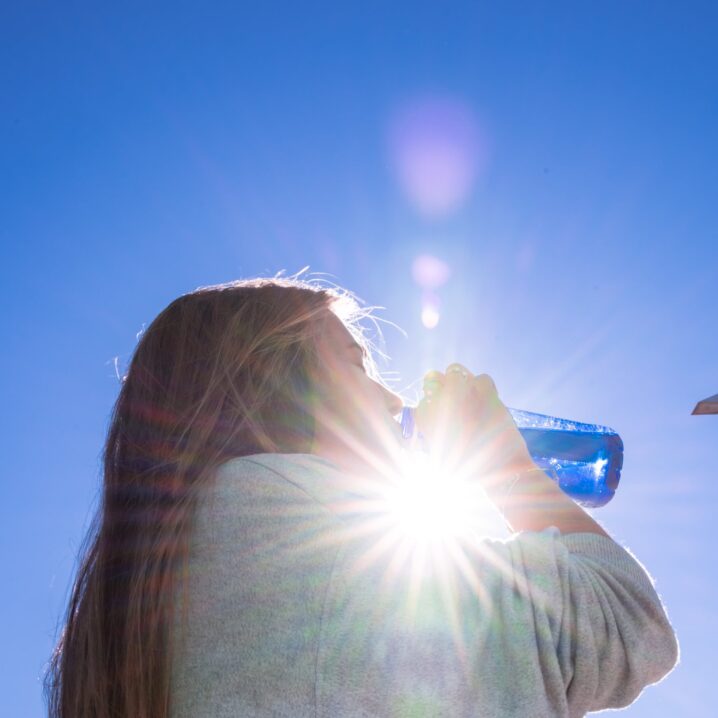
- POPSUGAR Australia
- Fitness
- Heat Exhaustion Can Sneak Up on You; Here’s How to Recognize the Signs
Heat Exhaustion Can Sneak Up on You; Here’s How to Recognize the Signs

Now that we’re well into the summer season, intense heat waves are taking over large parts of the US. Texas, for example, has had an excruciatingly hot climate for several weeks now, with temperatures reaching 115 degrees in some areas, according to NBC News. Heat advisories have also been issued in southeastern states like Virginia, North Carolina, South Carolina, Georgia, and Florida.
Western and southwestern states like California, Nevada, Arizona, and New Mexico are also suffering from sweltering heat. In fact, excessive heat warnings were issued in Phoenix during the week of July 3 as the temperature reached 116 degrees. On the same day, a woman was pronounced dead after becoming unconscious during a hike in the Grand Canyon, where the temperature was over 100 degrees, per ABC7. Parts of the canyon were under excessive heat warnings.
According to the National Weather Service, a heat wave is a period of abnormally hot weather lasting more than two days. These waves can strain our bodies, resulting in illness and, in extreme cases, death. In this kind of weather, it’s important to recognize the signs of heat-related illnesses and know when to seek medical treatment. Ahead, learn all about heat exhaustion, including what it is, the first signs of heat exhaustion, heat exhaustion recovery time, and heat exhaustion vs. heat stroke.
What Is Heat Exhaustion?
There are three heat-related illnesses to watch out for: heat cramps, heat exhaustion, and heat stroke. Heat cramps are the mildest, with symptoms such as heavy sweating, fatigue, and muscle cramps, according to Mayo Clinic. You can treat heat cramps with rest and hydration. Heat exhaustion can cause more severe symptoms, such as dizziness, rapid pulse, nausea, and headaches, as well as cramping and fatigue. When left untreated, heat exhaustion can develop into heat stroke, which can be life-threatening and require emergency medical attention.
What Are the First Signs of Heat Exhaustion?
Symptoms of heat exhaustion can start suddenly or progress over time, per Mayo Clinic. But here are some initial signs and symptoms the clinic suggests to look out for:
- Heavy sweating
- Dizziness
- Faintness
- Weak, rapid pulse
- Cool, moist skin
- Muscle cramps
- Nausea
- Headaches
- Fatigue
- Low blood pressure upon standing
Heat Stroke vs. Heat Exhaustion
Heat stroke and heat exhaustion share many symptoms, but they differ in severity. “The biggest difference, quite simply, is that heat stroke can be fatal if untreated,” says Kara Telesmanick, MD, Inspira Health Urgent Care physician. “To identify heat stroke, be on the lookout for an altered mental state, rapid breathing, and flushed skin, in addition to the symptoms that accompany the initial heat exhaustion. Someone experiencing heat stroke may also stop sweating, which can be deceiving in recognizing the condition.”
Once your body temperature hits 104 degrees, it’s likely that you have heat stroke. A temperature that high can cause fatal organ damage, so you should seek immediate emergency treatment. “On the way to [treatment], the affected person should drink cold water and apply cool compresses that help to cool the body down gradually,” Dr. Telemanick says.
What Increases the Risk of Heat Exhaustion?
There are certain factors that increase the likelihood of heat exhaustion or heat stroke. Older people and children, for example, are at higher risk in extreme heat, as are people with chronic health conditions like heart or lung disease, according to Mayo Clinic.
But what most people don’t realize is that certain medications – including antidepressants and antipsychotics – can interfere with your body’s ability to regulate temperature, per Mayo Clinic. Common antidepressants that can increase your risk of heat-related illness include Fluoxetine (Prozac, Sarafem, Symbyax), Citalopram (Celexa), Escitalopram (Lexapro), Fluvoxamine (Luvox), Paroxetine (Paxil, Pexeva), Sertraline (Zoloft), and Trazodone.
Additionally, migraine and allergy medications reduce sweating, which is a key way your body cools itself down in the heat, according to US Pharmacist. Stimulants, as sometimes prescribed to people with ADHD, also make you more likely to experience heat-related illnesses because they raise your base body temperature. And diuretics (such as spironolactone, a drug commonly prescribed for acne) also increase the risk of dehydration, which is often a factor in heat exhaustion. Don’t stop taking your medication just because it’s listed here; if you’re concerned about heat exhaustion and you’re taking one of these drugs, chat with your healthcare provider about the best plan of action.
How Do You Treat Heat Exhaustion?
If you have any symptoms of heat exhaustion, you should take action ASAP. For starters, try to lower your body temperature as soon as possible, Dr. Telemanick says: “Drink plenty of fluids, remove tight or extra clothing layers, take a cold shower or use cold compresses, and move to an air-conditioned area.”
As with most illnesses, the best medicine for a heat-related illness is prevention, Dr. Telemanick says: “By being cautious of how much time you spend in the sun, along with drinking plenty of fluids and staying in shaded areas, you can make yourself much more likely to be safe from falling ill.”
How Long Does Heat Exhaustion Last?
If you treat your symptoms quickly, you should start feeling better within an hour. If symptoms aren’t improving, see a doctor immediately. Your healthcare team may need to employ other methods of treatment, including cold-water immersion, packing you with ice and cooling blankets, and giving you a muscle relaxant to help with shivering, according to Mayo Clinic.
47723652

